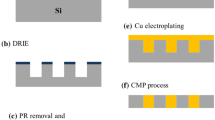Abstract
Hermetic seal and mechanical support of wafer-level Cu-to-Cu thermo-compression bonding with different bonding temperature are analyzed in this work. The investigation consists of two parts: hermetic seal study using helium bomb test and mechanical support study using four-point bending method. The wafer pairs are bonded at 250, 300 and 350 °C, respectively, under a bonding force of 5,500 N for a duration of 1 h in vacuum (~2.5 × 10−4 mbar). The bonding medium consists of Cu (300 nm) bonding layer and Ti (50 nm) barrier layer. Excellent helium leak rate, which is smaller than the reject limit defined by MIL-STD-883E standard (method 1014.10), and outstanding interfacial adhesion energy are detected for all samples. The cavities sealed at 300 °C present an excellent reliability of temperature cycling test up to 500 cycles. Cu-to-Cu thermo-compression bonding at low temperature (≤300 °C) presents an attractive hermetic seal and a robust mechanical support for 3D integration application.






Similar content being viewed by others
References
Beyne E (2006) 3D System integration technologies. In: 2006 International Symposium on VLSI Technology, Systems, and Applications, Hsinchu. IEEE, pp 19–27. doi:10.1109/VTSA.2006.251113
Chen KN, Fan A, Reif R (2001) Microstructure examination of copper wafer bonding. J Electron Mater 30(4):331–335. doi:10.1007/s11664-001-0039-6
Chen KN, Tan CS, Fan A, Reif R (2004) Morphology and bond strength of copper wafer bonding. Electrochem Solid-State Lett 7(1):G14–G16. doi:10.1149/1.1626994
Chong GY, Tan CS (2009) Low temperature PE-TEOS oxide bonding assisted by a thin layer of high-kappa dielectric. Electrochem Solid-State Lett 12(11):H408–H411. doi:10.1149/1.3207872
Davis WR, Wilson J, Mick S, Xu M, Hhua H, Mineo C, Sule AM, Steer M, Franzon PD (2005) Demystifying 3D ICs: the procs and cons of going vertical. IEEE Des Test Comput 22(6):498–510. doi:10.1109/mdt.2005.136
Fan J, Lim DF, Peng L, Li KH, Tan CS (2011) Low temperature Cu-to-Cu bonding for wafer-level hermetic encapsulation of 3D microsystems. Electrochem Solid-State Lett 14(11):H470–H474. doi:10.1149/2.025111esl
Jang EJ, Hyun S, Lee HJ, Park YB (2009) Effect of wet pretreatment on interfacial adhesion energy of Cu–Cu thermocompression bond for 3D IC packages. J Electro Mater 38(12):2449–2454. doi:10.1007/s11664-009-0942-9
Kim YK, Kim EK, Kim SW, Ju BK (2008) Low temperature epoxy bonding for wafer level MEMS packaging. Sens Actuators, A 143(2):323–328. doi:10.1016/j.sna.2007.10.048
Kim B, Matthias T, Cakmak E, Jang EJ, Kim JW, Park YB (2010) Interfacial properties of Cu–Cu direct bonds for TSV integration. Solid State Technol 53(8):18–21
Ko CT, Chen KN (2010) Wafer-level bonding/stacking technology for 3D integration. Microelectron Reliab 50(4):481–488. doi:10.1016/j.microrel.2009.09.015
Koob JC, Leder DA, Sung RJ, Brandon TL, Elliott DG, Cockburn BF, McIlrath L (2005) Design of a 3-D fully depleted SOI computational RAM. IEEE Trans VLSI Syst 13(3):358–369. doi:10.1109/tvlsi.2004.842890
Kwon S, Kim J, Park G, Hong Y, Ju B, Song I (2009) RF device package method using Au to Au direct bonding technology. Microelectron Reliab 49(1):99–102. doi:10.1016/j.microrel.2008.10.007
Lee SH, Mitchell J, Welch W, Lee S, Najafi K (2010) Wafer-level vacuum/hermetic packaging technologies for MEMS. In: reliability, packaging, testing, and characterization of Mems/Moems and nanodevices Ix. Proceedings of SPIE. p 759205. doi:10.1117/12.843831
Lu JQ, Kwon Y, Kraft RP, Gutmann RJ, McDonald JF, Cale TS (2001) Stacked chip-to-chip interconnections using wafer bonding technology with dielectric bonding glues. In: IEEE 2001 international interconnect technology conference, Piscataway, NJ, USA. IEEE, pp 219-221. doi:10.1109/iitc.2001.930066
Morrow PR, Park CM, Ramanathan S, Kobrinsky MJ, Harmes M (2006) Three-dimensional wafer stacking via Cu–Cu bonding integrated with 65 nm strained-Si/low-k CMOS technology. IEEE Electron Device Lett 27(5):335–337. doi:10.1109/led.2006.873424
Oberhammer J, Niklaus F, Stemme G (2004) Sealing of aadhesive bonded devices on wafer level. Sens Actuators A 110(1–3):407–412. doi:10.1016/j.sna.2003.06.003
Tadepalli R, Thompson CV (2003) Quantitative characterization and process optimization of low-temperature bonded copper interconnects for 3-D integrated circuits. In: IEEE international Interconnect Technology Conference, Burlingame, CA, USA. IEEE, pp 36–38. doi:10.1109/IITC.2003.1219705
Tan CS (2010) Thermal characteristic of Cu–Cu bonding layer in 3-D integrated circuits stack. Microelectron Eng 87(4):682–685. doi:10.1016/j.mee.2009.09.009
Tan CS, Reif R (2005) Silicon multilayer stacking based on copper wafer bonding. Electrochem Solid-State Lett 8(6):G147–G149. doi:10.1149/1.1904506
Tan CS, Fan J, Lim DF, Chong GY, Li KH (2011) Low temperature wafer-level bonding for hermetic packaging of 3D microsystems. J Micromech Microeng 21(7):075006. doi:10.1088/0960-1317/21/7/075006
Tao Y, Malshe AP (2005) Theoretical investigation on hermeticity testing of MEMS packages based on MIL-STD-883E. Microelectron Reliab 45(3–4):559–566. doi:10.1016/j.microrel.2004.08.004
Tilmans HAC, Van de Peer MDJ, Beyne E (2000) The indent reflow sealing (IRS) technique—a method for the fabrication of sealed cavities for MEMS devices. J Microelectromech Syst 9(2):206–217. doi:10.1109/84.846701
Tsau CH, Spearing SM, Schmidt MA (2004) Characterization of wafer-level thermocompression bonds. J Microelectromech Syst 13(6):963–971. doi:10.1109/jmems.2004.838393
Wei J, **e H, Nai ML, Wong CK, Lee LC (2003) Low temperature wafer anodic bonding. J Micromech Microeng 13(2):217–222. doi:10.1088/0960-1317/13/2/308
Xu DH, **g ER, **ong B, Wang YL (2010) Wafer-Level vacuum packaging of micromachined thermoelectric IR sensors. IEEE T Adv Pack 33(4):904–911. doi:10.1109/tadvp.2010.2072925
Yu DQ, Lee C, Yan LL, Thew ML, Lau JH (2009) Characterization and reliability study of low temperature hermetic wafer level bonding using In/Sn interlayer and Cu/Ni/Au metallization. J Alloy Compd 485(1–2):444–450. doi:10.1016/j.jallcom.2009.05.136
Yun CH, Martin JR, Tarvin EB, Winbigler JT (2008) Al to Al Wafer bonding for MEMS encapsulation and 3-D interconnect. In: IEEE International Conference on Microelectromechanical Systems, Tucson, AZ, USA. IEEE, pp 810–813. doi:10.1109/MEMSYS.2008.4443780
Acknowledgments
This work has been carried out as part of the Nanyang Assistant Professorship supported by Nanyang Technological University (NTU). Partial funding is also provided by Defence Science and Technology Agency (DSTA), Singapore. Authors are grateful for support provided by the management and technical staff in the Nanyang Nano-Fabrication Center at NTU.
Author information
Authors and Affiliations
Corresponding author
Rights and permissions
About this article
Cite this article
Fan, J., Lim, D.F., Peng, L. et al. Effect of bonding temperature on hermetic seal and mechanical support of wafer-level Cu-to-Cu thermo-compression bonding for 3D integration. Microsyst Technol 19, 661–667 (2013). https://doi.org/10.1007/s00542-012-1689-4
Received:
Accepted:
Published:
Issue Date:
DOI: https://doi.org/10.1007/s00542-012-1689-4




